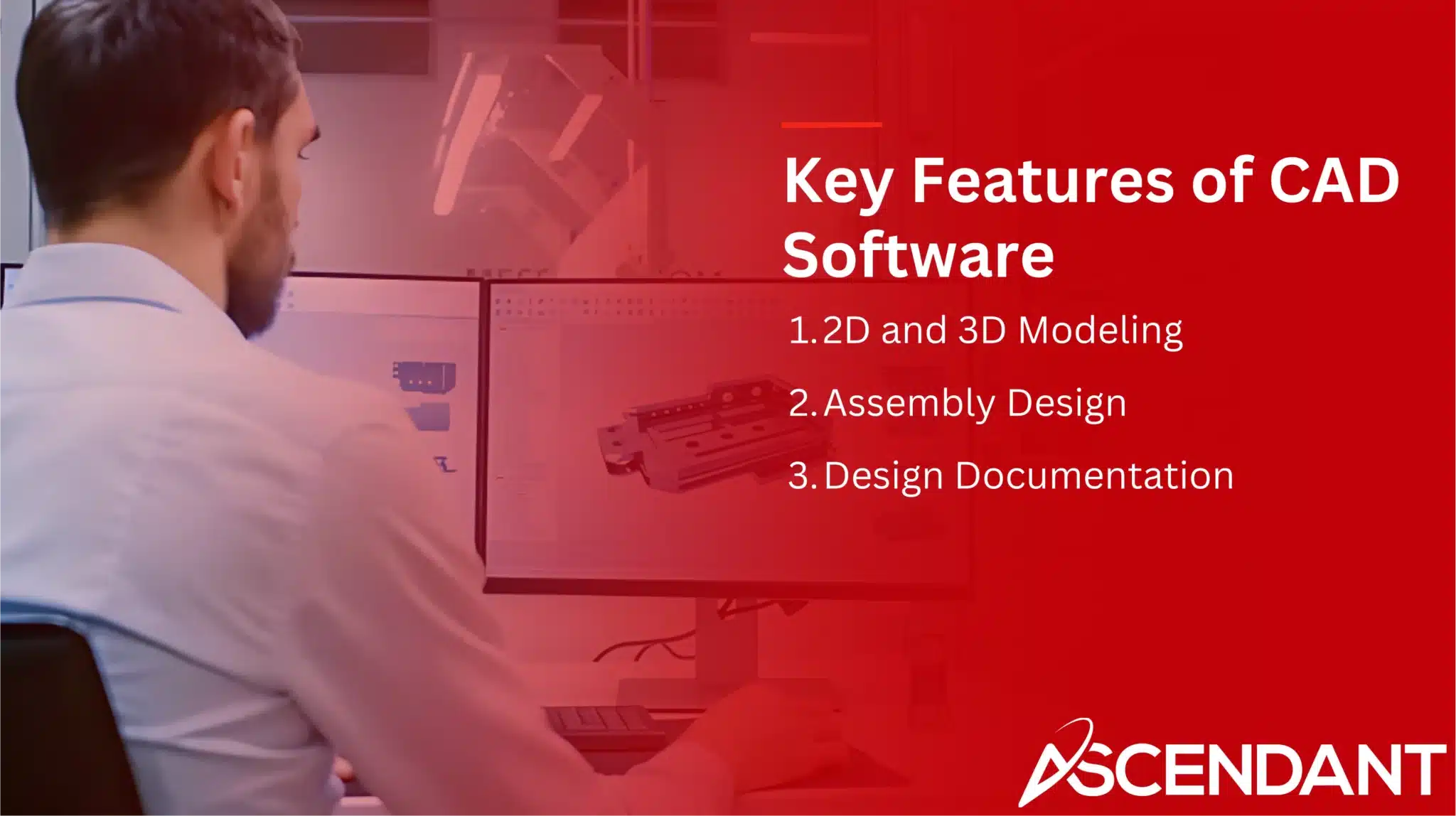Computer-Aided Design (CAD) uses computers to create and modify designs. It is essential in engineering, architecture, and many other fields, offering 2D and 3D models that improve precision and efficiency. This guide explores what is CAD, its key features, benefits, and applications in various industries.
In This Article:
- Understanding Computer-Aided Design (CAD)
- Key Features of CAD Software
- Types of CAD Software
- Benefits of Using CAD Software
- Applications of CAD in Various Industries
- Choosing the Right CAD Software
- CAD File Formats
- Cloud-Based CAD Solutions
Key Takeaways
- CAD (Computer-Aided Design) is crucial in multiple industries, providing tools for creating, modifying, and optimizing designs through advanced software, significantly improving accuracy and efficiency compared to traditional manual drafting.
- The primary types of CAD software, 2D and 3D, serve distinct purposes, with 2D CAD focusing on technical documentation and 3D CAD offering detailed models that facilitate effective visualization and simulation of designs.
- Cloud-based CAD solutions enhance collaboration and accessibility for design teams, allowing real-time, multiuser interactions and simplifying project management while ensuring data security and compliance.
Understanding Computer-Aided Design (CAD)
Computer-aided design (CAD) utilizes computer technology for the creation, alteration, analysis, or enhancement of designs. This method is pivotal in disciplines such as engineering, architecture, and manufacturing where it has supplanted old-school manual drafting methods with sophisticated CAD software. The software chiefly generates either two-dimensional drawings or three-dimensional models that provide precise and intricate portrayals of products before they are manufactured.
Utilizing CAD enables designers and engineers to preemptively visualize how a product will be constructed, which aids in pinpointing and rectifying potential flaws at an early stage within the design process.
The use of CAD software streamlines the production of essential technical documentation required for both manufacturing and construction processes. It encompasses all aspects from preliminary sketches to detailed final design blueprints thus refining precision and efficacy throughout the entire range of design operations.
Key Features of CAD Software
CAD software’s transformative power stems from its robust features that enhance the design process, categorized into design, drafting, and modeling. Most tools offer advanced capabilities and 3D visualization, making them indispensable in modern workflows.
Associativity in CAD programs ensures that changes in one element automatically update related components, reducing error risks. Key features include advanced design, drafting aids, and 3D visualization.
2D and 3D Modeling
Two main categories exist within computer aided design (CAD) software: 2D CAD and 3D CAD, both essential for different stages of the design process. Programs such as AutoCAD LT are paramount in the realm of 2D CAD, offering precise flat drawings that form an integral part of technical documentation and conceptual planning. On the other hand, 3D CAD enables intricate three-dimensional representations critical for detailed analysis.
The provision of realistic visualizations by programs like Autodesk’s portfolio allows engineers and product designers to virtually examine their creations before they take physical form. This advanced capability to model real-world objects in a virtual space streamlines processes through early detection of potential issues, optimizing efficiency by saving time and reducing waste.
By integrating various tools from the cad industry—be it computer based software or more dedicated systems—the versatility offered between creating simplistic designs with 2d cad or comprehensive models using 3d cad caters comprehensively to professionals across disciplines. These robust options afford users not just precision but also flexibility throughout their work with computer aided design models within any given cad system.
Assembly Design
Design tools for assembly in CAD software play a crucial role in enabling designers to visualize and refine the configuration of intricate components, guaranteeing that each piece aligns and operates as intended.
During engineering projects, accurate assembly is critical for the structural soundness and operational effectiveness of the end product. Through virtual simulations within CAD software, designers can pinpoint and resolve possible problems before manufacturing physical prototypes, thereby streamlining processes while diminishing expenses.
Design Documentation
CAD software plays a crucial role in generating thorough design documentation, equipped with features for dimensioning and adding notes to technical drawings. This precise documentation is key to making sure the finished product aligns with the intended design specifications, thereby reducing mistakes and subsequent corrections.
The software shines in crafting unambiguous and exact documents that are readily interpretable by every involved party, enhancing the efficacy of the design workflow while guaranteeing that the final output adheres to necessary standards and criteria.
Throughout all stages—from initial concepts to comprehensive schematics—CAD software offers an array of tools indispensable for cataloguing each segment of the design process. This ensures a seamless progression from idea development straight through to manufacturing.
Types of CAD Software
Various forms of CAD software are available, each designed for distinct design requirements. The main divisions are 2D and 3D CAD, both providing distinctive features and advantages crucial for choosing the appropriate tools for a particular project.
We should explore these categories to grasp their capabilities and uses thoroughly.
2D CAD
Even with the trend toward 3D design, numerous industries, notably those in architecture and engineering fields, still heavily rely on 2D CAD for essential operations. This type of software employs basic shapes to produce flat drawings that are crucial in developing and recording design concepts. AutoCAD LT stands out as a widely recognized tool known for its adeptness at generating intricate technical drawings and comprehensive documentation.
Compared to conventional hand-drawn methods, the precision and efficiency offered by 2D CAD dramatically improve the overall process of designing. Such software plays an integral role not only in crafting detailed 2D plans, but also supports creating 3D models that help visualize potential outcomes prior to actual production. They come equipped with extensive document creation capabilities necessary for churning out production-related materials like assembly instructions.
3D CAD
Advancements in 3D CAD software have transformed the way objects are designed by offering detailed three-dimensional visualizations. Utilizing techniques such as solid modeling, wireframe modeling, and surface modeling allows for varying degrees of detail and complexity that are vital for constructing lifelike models. These models can undergo virtual testing, providing an all-encompassing perspective from every angle.
A range of features like rendering and animation is included within many 3D CAD tools to improve visualization and aid in conveying design concepts effectively. Such capabilities are particularly advantageous in fields like engineering and manufacturing where precise and accurate models play a pivotal role during prototyping stages as well as throughout production processes.
The ability to simulate conditions mirroring the real world enables designers using these sophisticated CAD tools to pinpoint potential issues early on in the design process. This proactive approach enhances overall efficiency while simultaneously reducing costs associated with designing products using traditional methods without such technology.
Benefits of Using CAD Software
CAD software significantly boosts the design process in numerous industries, offering increased efficiency and productivity. By automating repetitive tasks, supplying templates, and generating intelligent components, it simplifies workflows and cuts down on the time needed to complete projects. Its intuitive interface helps reduce the learning curve for newcomers, Promoting productivity.
The precision and detail provided by CAD are other substantial advantages. This software facilitates exact measurements and intricate representations that surpass old-fashioned hand-drawn techniques. Such accuracy minimizes mistakes while guaranteeing that the final product adheres to all specified requirements.
CAD supports seamless real-time collaboration among teams regardless of their physical locations. This capability expedites the design process while maintaining alignment among team members throughout each stage of development—leading to enhanced end results.
Applications of CAD in Various Industries
Software for Computer-Aided Design (CAD) is employed in a wide array of sectors, all having distinct needs and uses. These industries range from architecture and construction to engineering, manufacturing, as well as life sciences and healthcare. CAD improves the precision and efficiency of designs.
We will delve into the various applications of CAD within these different areas.
Architecture and Construction
In the fields of architecture and construction, the use of CAD software is essential for generating detailed plans and visual representations. Architects employ these CAD tools to convert preliminary hand-drawn sketches into elaborate 2D and 3D models, improving both visualization quality and engagement with clients. These models provide a meticulous depiction of the proposed structure, verifying that every design element is considered prior to initiating construction.
CAD plays a pivotal role in fostering communication and teamwork among architects, engineers, and all involved parties by presenting clear and intricate visualizations that facilitate early detection of potential issues. This proactive approach allows for necessary modifications before the ground is broken on a project. As a result, it bolsters design efficiency while also ensuring that the completed building conforms to all requisite criteria and norms.
Engineering and Manufacturing
Within the realms of engineering and manufacturing, CAD tools are indispensable for crafting accurate prototypes and facilitating rapid design modifications, both pivotal aspects of product advancement. Designers utilize 3D CAD software to construct intricate models that imitate conditions they’ll encounter in actual use scenarios. This assists with troubleshooting and refining designs prior to initiating production. The ability to visualize complex mechanical assemblies with precision is particularly vital, guaranteeing the compatibility and functionality of all elements.
The implementation of CAD significantly expedites the prototyping phase, empowering engineers to quickly generate and evaluate various design alternatives. This bolsters productivity while simultaneously cutting down costs by diminishing reliance on constructing numerous physical prototypes. It also allows for earlier detection of potential design flaws. Contemporary 3D CAD programs incorporate state-of-the-art technologies that improve upon existing processes and simulation capabilities even further.
Life Sciences and Healthcare
Life sciences and healthcare sectors benefit significantly from CAD technology. CAD is used to design medical devices, ensuring they meet stringent industry standards for safety and functionality. Precise models enhance patient treatment options and ensure devices fit individual needs.
This includes prototyping prosthetics, where CAD ensures design accuracy and proper fit.
Choosing the Right CAD Software
Choosing the appropriate CAD software is a pivotal choice that hinges on considerations such as the intricacy of the product and specific project requirements. Evaluate if its features represent substantial advancements or just slight enhancements. Cost-effectiveness must also be taken into account since there are complimentary and economical options compared to premium CAD software.
In selecting CAD software, it’s wise to investigate whether it is incorporated into local academic programs, which suggests it may be more user-friendly and supported by an engaged community. Organizations ought to look for customized assistance, instructional opportunities, and comprehensive documentation from providers in order to fully exploit what the software offers.
Utilizing trial versions of CAD software can prove immensely beneficial. They empower users with firsthand experience regarding performance levels and help uncover any potential drawbacks prior to making a purchase decision.
CAD File Formats
CAD software generates files in two main types of formats: native and neutral, both with distinct advantages and disadvantages. Native file formats such as DWG, SLDPRT, and CATPart are specific to certain CAD systems and may present challenges when it comes to access or compatibility across different platforms – a potential issue for users who need to exchange native CAD files among various collaborators using disparate CAD applications.
On the other hand, neutral file formats like STEP, QIF, and JT are designed for seamless data exchange between numerous CAD programs. These facilitate collaborative efforts by ensuring cross-application compatibility. When choosing CAD software, it is essential to ensure that it supports relevant file formats, including the Initial Graphics Exchange Specification (IGES), thus averting any interoperability complications that might arise from incompatible software environments.
Cloud-Based CAD Solutions
Utilizing the power of the internet, cloud-based CAD solutions have revolutionized how engineers and designers execute their tasks. These platforms empower individuals to engage with their design projects from any location that offers an internet connection, thus bolstering flexibility and fostering better teamwork. The ability to conduct real-time work on projects by multiple users concurrently stands out as a key feature of cloud CAD systems. This capability ensures efficient team collaboration, heightened productivity, and maintains consistency across all members’ efforts through simultaneous access to the most updated design iteration.
Cloud-based CAD platforms don’t just enhance team cooperation. They also simplify file management significantly. With automatic data backups in place and no need for manual software upgrades, these solutions reduce complexities associated with managing project files.
Cloud services commit to high-level data security protocols while regularly undergoing audits—measures which guarantee protection for sensitive design details. By merging improved teamwork capabilities with straightforward management processes and stringent security measures, cloud-based CAD presents itself as an appealing choice for contemporary engineering and designer groups looking toward innovative methods of operation.
Summary
In essence, the advent of Computer-Aided Design (CAD) has been transformative for design and manufacturing across numerous sectors by improving precision, streamlining cooperation, and bolstering efficiency. This guide offered an all-encompassing examination of CAD’s essential aspects, functionality features, and wide-ranging applications within diverse industries. It underscored how crucial benefits of this technology empower designers to produce intricate models with heightened accuracy while optimizing their workflows for quicker project completion. Adopting CAD can significantly uplift your design practices, helping you realize your inventive aspirations and engineering objectives with enhanced ease.
 Frequently Asked Questions
Frequently Asked Questions
What is CAD?
Computer-Aided Design (CAD) is a form of technology utilized for the development, alteration, examination, and refinement of designs using specialized computer software.
Such an influential instrument improves both accuracy and productivity within the process of design.
What are the main types of CAD software?
The main types of CAD software are 2D CAD, which focuses on flat drawings, and 3D CAD, which offers detailed three-dimensional representations.
Both serve distinct purposes in design and engineering processes.
What are the benefits of using CAD software?
The employment of CAD software greatly improves both the efficiency and precision within design processes. It also facilitates immediate cooperation among team members and eases the process of making modifications to designs.
In essence, this software optimizes workflow management and leads to better results in projects.
How is CAD used in architecture and construction?
CAD is essential in architecture and construction for creating detailed building plans and visualizations, which improve communication and collaboration among all stakeholders involved.
What should I consider when choosing CAD software?
When choosing CAD software, it is essential to consider the complexity of the products, affordability, ease of learning, available support and training, and compatibility with other software.
These factors will ensure you select software that meets your specific design needs effectively.


